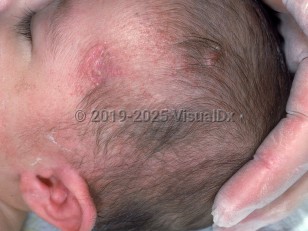DiGeorge syndrome
Alerts and Notices
Important News & Links
Synopsis

DiGeorge syndrome (DGS) is a relatively common constellation of findings associated with a hemizygous mutation in chromosome 22q11. Embryologically, there is developmental failure of the third and fourth pharyngeal pouches, which correlates to the physiological consequences. Patients present with hypoplastic to absent thymus along with absence of parathyroid glands, pharyngeal muscle abnormalities, and congenital cardiac anomalies. Cutaneous manifestations are nonspecific, but seborrheic dermatitis and eczematous dermatitis are commonly reported.
Also within the spectrum of conditions associated with mutations on 22q11 is velocardiofacial syndrome, which is often difficult to distinguish clinically. Clinical features of velocardiofacial syndrome include pharyngeal dysfunction, cardiac anomaly, and dysmorphic facies.
Many patients have features of both DGS and velocardiofacial syndrome, and the condition is increasingly being called 22q11.2 deletion syndrome, with less of an emphasis on distinguishing between the two. Because of the complex phenotypic heterogeneity of this condition, incidence is difficult to determine, but it is thought to be around 1 in 4000 live births.
Patients with DGS can present from birth to adulthood. Those with severe phenotypes are often diagnosed in infancy. Conversely, patients with milder phenotypes are often not diagnosed until adulthood.
The most common features are cardiac anomalies, hypocalcemia, and recurrent infections secondary to hypoplastic thymus. Patients can also have cleft palate and speech delay as well as psychiatric disease, including schizophrenia and hyperactivity.
Special considerations in infants: This diagnosis should be considered in any infant with congenital cardiac abnormalities, tetany resulting from hypocalcemia, or absent / reduced thymic shadow.
Also within the spectrum of conditions associated with mutations on 22q11 is velocardiofacial syndrome, which is often difficult to distinguish clinically. Clinical features of velocardiofacial syndrome include pharyngeal dysfunction, cardiac anomaly, and dysmorphic facies.
Many patients have features of both DGS and velocardiofacial syndrome, and the condition is increasingly being called 22q11.2 deletion syndrome, with less of an emphasis on distinguishing between the two. Because of the complex phenotypic heterogeneity of this condition, incidence is difficult to determine, but it is thought to be around 1 in 4000 live births.
Patients with DGS can present from birth to adulthood. Those with severe phenotypes are often diagnosed in infancy. Conversely, patients with milder phenotypes are often not diagnosed until adulthood.
The most common features are cardiac anomalies, hypocalcemia, and recurrent infections secondary to hypoplastic thymus. Patients can also have cleft palate and speech delay as well as psychiatric disease, including schizophrenia and hyperactivity.
Special considerations in infants: This diagnosis should be considered in any infant with congenital cardiac abnormalities, tetany resulting from hypocalcemia, or absent / reduced thymic shadow.
Codes
ICD10CM:
D82.1 – Di George's syndrome
SNOMEDCT:
767263007 – 22q11.2 deletion syndrome
D82.1 – Di George's syndrome
SNOMEDCT:
767263007 – 22q11.2 deletion syndrome
Look For
Subscription Required
Diagnostic Pearls
Subscription Required
Differential Diagnosis & Pitfalls

To perform a comparison, select diagnoses from the classic differential
Subscription Required
Best Tests
Subscription Required
Management Pearls
Subscription Required
Therapy
Subscription Required
References
Subscription Required
Last Updated:01/30/2022

